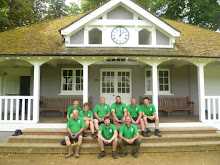Ali has been photographing, filming and observing the pair of Mute Swans that reside on the college lake since they first arrived in early spring of 2012. It is with great sadness, therefore, that she now has to report the death of the female swan this morning at Tiggywinkles Wildlife Hospital, the vets were unable to save her and made the decision that the kindest thing for her was to put her to sleep.
 |
| 16th January 2013, Lake Frozen Over But A Path Through The Ice Has Been Cleared By The Pair |
 |
| Is That A Cricket Ball On The Lake, Fancy A Game? No, I Can Hardly Stand Up! |
The swan's story may have begun way back in 2009 when a young swan first visited the college gardens, well Ali likes to think so,and walked up to her, see blog entry
'Wildlife' dated 19th November, maybe the swan was checking out the lake for its arrival 3 years later!
The pair of swans first arrived on the college lake in March 2012, the blog entry on the 19th July noted:
"The pair of swans arrived on the college lake back in March and stayed
for three months until the end of June. During this time the swans
managed to crash land in the Fellow's Garden and on the front quad lawn,
having to be captured and returned to the lake.
Where our swans have gone we don't know, but hopefully they will return next year."
And return they did, returning in early 2013 and, for the first time, built a large nest in amongst the reeds, see blog entry 1st May
'Nesting Swans'. The first ever egg laid by the swans appeared on the nest on Friday 3rd May, see
'The First Egg Laid', but alas after a long incubating period, see
'The Swans Are Incubating Their Eggs' ,
'Four Swan Eggs' and
'A Strong Instinct To Brood' the nest and its precious contents were left behind as the swans flew off, see
'Swan Nest And Eggs Abandoned' on the 11th July, 4 eggs, no cygnets.
In 2014 they returned in January, the blog entry of the 9th January noted:
"By the end of a busy day by the weir, the team were treated to a visit
by the swans that had just arrived on the lake. This time last year,
11th January to be exact, the swans arrived on the lake, the same pair
possibly, the lake may well be their mating territory."
"If they are, it is their third year, always arriving in early January.
In their first year they mated, started building a nest, then left and
then last year they mated, built a nest, laid eggs but left after they
failed to hatch. This year, hopefully, their 3rd and our 300th, they
will go one step further and successfully hatch eggs and cygnets will be
seen on the lake."
They began to rebuild the nest in mid March, six weeks earlier than last year,
'Rebuilding Last Year's Nest', laying their first egg on the 27th March
'The First Egg Laid (2014)'. By the 18th June they had again left the nest and its contents but stayed on the lake rather than fly away,
'Swans Abandon Their Nest', 7 eggs, still no cygnets.
In 2015 the swans left the lake at the beginning of the year but returned a month later, the blog entry for the 10th March,
'The Swans Return' noted:
"The swans left the college lake on the 10th February, to where is unknown, but today, exactly a month later, they have returned."
"Ali will be watching them to see when the begin to rebuild this year and, hopefully, it will be third time lucky for the swans."
The nest that the swans tentatively started to build in 2012 and rebuilt over the next two years was rebuilt again for this year. On the 16th April the Pen, female, started to lay her clutch of eggs,
'Swans (First Egg 2015), but
'The Swans Lose One Egg' a few days later, they continued to incubate through April and May,
'The Reed Bed Maternity Unit' and
'The Swan Is Still Incubating And The Goslings Are Growing Up Fast' but once again left the nest after the eggs didn't hatch,
'The Success And Failures Of The College Waterfowl', 3 eggs, still no cygnets.
 |
| 12th April 2016 |
This year the swans never left the lake in February becoming permanent residents, begining to rebuild the nest on the 11th March, laying the first of this year's clutch ten days later, see blog entry 21st March
'Swans Lay Their First Egg (And Bird Update)'. The largest number of eggs were laid this year, 9 in total, and were incubated throughout April and May but, as with the last 3 years, the eggs did not hatch and the nest was abandoned on the 8th June.
Six weeks later the female swan was discovered in the reeds near to her nest in poor condition, see blog entry for the 25th July
'Swan Rescue'. She was rescued from the lake by the RSPCA and taken to Tiggywinkles Wildlife Hospital for treatment but after 5 weeks the desicion was taken by the vet that, although the wing injury had healed, her condition had deteriated and it would be kinder to stop her from suffering anymore so she was put to sleep, a tragic end for the pair of swans.
 |
| Turning The 9 Eggs |
 |
| 12th April 2016 9 Eggs |
| | | | |
 |
| 22nd April 2016 The Cob Protecting His Pen On The Nest |
 |
| Devoted To Each Other 22nd April2016 |
 |
| Bonded For Life |
 |
| The Swan At Sunset |
























































